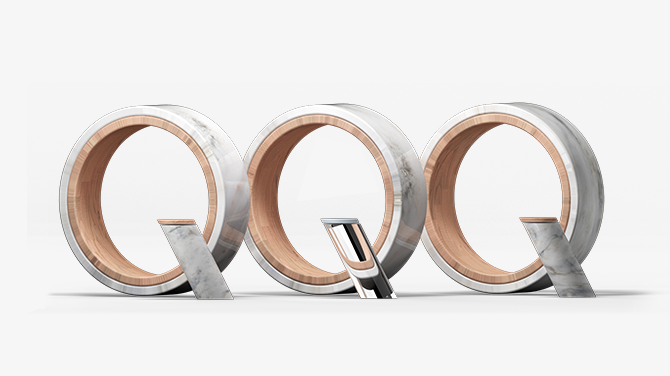
QQQM: Innovation for the long term
The Invesco NASDAQ 100 ETF’s (QQQM) exposure to innovative companies, attractive value, and tax efficiency may appeal to equity investors looking for long-term growth.
The evolution of the Nasdaq-100 Index and QQQ over the last 25 years demonstrates the progression of innovation and technology to create a competitive edge in the market.
Innovation Suite launched as a cost-effective option to complement the investment objectives of investors who want access to innovative companies across the Nasdaq composite.
Investors have the opportunity to potentially enhance their portfolio allocation and build an innovative portfolio with our suite, offering access to forward-thinking companies across the market-cap spectrum.
Hi, I’m Ryan McCormack, Invesco’s Senior Director of Factor & QQQ Equity Product Strategy.
Innovation is constantly reshaping the world, and we want investors to be able to take part in it. We started 25 years ago with Invesco QQQ, our flagship ETF tracking the Nasdaq-100 Index, which invests in companies at the forefront of long-term innovative themes shaping today’s economy.
Building on QQQ’s success, we launched the Innovation Suite, a collection of ETFs investing across the Nasdaq ecosystem. Whether you're looking to grow your investment, diversify your portfolio, generate income, or tap into emerging themes, these ETFs offer tailored solutions to help meet your goals while staying ahead of market trends. They can enhance a core stock allocation, complement a value strategy, provide consistent income, or serve as a low-fee alternative to something you already own.
Our Innovation Suite ETFs offer multiple ways to invest in innovative and forward-thinking companies with strong fundamentals across investment styles, sectors, and market capitalization.
For example:
Explore Invesco's QQQ Innovation Suite to invest in tomorrow’s opportunities today and help you meet your investing goals.
Get access to the most groundbreaking companies in the Nasdaq indexes with Invesco’s QQQ Innovation Suite. Whether you're seeking growth, diversification, income, or thematic exposure, there could be a QQQ ETF for you.
* Gross Expense Ratio 0.48%
The Nasdaq-100 Index has provided investors with decades of strong large-cap performance. The chart below shows the total cumulative returns from March 10, 1999–June 30, 2025.
Source: Bloomberg L.P. Data is for total returns from March 10, 1999–June 30, 2025. The above chart is presented for the purpose of illustrating the long-term performance of large-cap growth markets versus the broader market over time. The starting time period was selected based on the inception of the oldest product in the Invesco QQQ Innovation Suite. QQQ has an existing performance record, which can be found here. Index performance is not indicative of Fund performance, nor is it an indication of how a Fund could or will perform. An investment cannot be made directly into an Index. Past performance is not a guarantee of future results.
The index includes the largest 100 non-financial companies listed on the Nasdaq Stock Market based on market capitalization. It rebalances quarterly and is reconstituted annually in early December.
QQQM can be used for US large-cap growth equity exposure in portfolios by accessing innovative companies with sound fundamentals that help drive global growth.
QQQJ provides exposure to growth-focused, Nasdaq-listed companies that may be earlier in their growth cycles than larger companies in the Nasdaq-100 Index.
QQQS can be used as a small-cap core holding that focuses on firms with growth potential as measured by the value of their patents.
Investors can get ETF exposure to some of the world’s most innovative companies across the market-cap spectrum with no overlap between strategies. ETFs in our Invesco QQQ Innovation Suite can be used to complement each other.

QQQM: Innovation for the long term
The Invesco NASDAQ 100 ETF’s (QQQM) exposure to innovative companies, attractive value, and tax efficiency may appeal to equity investors looking for long-term growth.

An innovative way to hedge exposure to the Nasdaq-100
Hedged equity strategies seek to mitigate market risk while participating in gains by combining long equity positions with hedging instruments such as options.

Explore our lineup of ETFs and see how they can be cost effective, tax-efficient tools for maximizing investments and building long-term wealth.

Access our latest insights on investment opportunities and ways to use ETFs in your portfolio.

Learn how Invesco QQQ gives investors access to some of today's most innovative companies, all in one exchange-traded fund (ETF).
QQQ
About this product
Provides exposure to the Nasdaq 100 Index. Comprised of companies at the forefront of innovation across a diverse range of sectors, all in one investment.
QQQJ
About this product
Provides exposure to forward-thinking mid-cap growth companies listed on the Nasdaq exchange and can complement to existing large-cap growth options.
QQQM
About this product
Provides cost-effective exposure to the Nasdaq 100 Index, the 100 largest nonfinancial companies listed on Nasdaq.
QQA
About this product
Designed to provide consistent monthly income and maintain growth potential — all while targeting less volatility and downside risk mitigation.
QQLV
About this product
Provides convenient access to the volatility factor within the Nasdaq 100 Index with potential downside mitigation during major drawdowns in the parent universe.
QQHG
About this product
Structured to closely replicate the Nasdaq-100 Index performance, incorporating an overlay strategy to partially hedge against downside exposure during equity market declines.
QBIG
About this product
Provides concentrated exposure to the largest companies in the Nasdaq 100 Index through a rules-based approach, to allow for flexibility and agility in a rapidly evolving marketplace.
QQQM
About this product
Provides cost-effective exposure to the Nasdaq 100 Index, the 100 largest nonfinancial companies listed on Nasdaq.
QQQS
About this product
Provides access to small-cap companies with promising patent portfolios relative to their market capitalization. Valuable patents may be an indicator of competitive advantages and potential future revenue growth.
QQMG
About this product
Provides access to the groundbreaking large-cap companies in the Nasdaq 100 Index while incorporating additional ESG screening criteria.
QQJG
About this product
Provides access to the groundbreaking mid-cap companies of the Nasdaq Next Generation Index while incorporating additional ESG screening criteria.
IVNQX
About this product
Seeks to track the investment results, before fees and expenses, of the Nasdaq 100 Index.
NA4796919
ETFs
There are risks involved with investing in ETFs, including possible loss of money. Shares are not actively managed and are subject to risks similar to those of stocks, including those regarding short selling and margin maintenance requirements. Ordinary brokerage commissions apply. The Fund’s return may not match the return of the Underlying Index. The Fund is subject to certain other risks. Please see the current prospectus for more information regarding the risk associated with an investment in the Fund.
Investments focused in a particular sector, such as information technology, are subject to greater risk, and are more greatly impacted by market volatility, than more diversified investments.
QQLV
In general, equity values fluctuate, sometimes widely, in response to activities specific to the company as well as general market, economic and political conditions.
Investments focused in a particular sector are subject to greater risk and are more greatly impacted by market volatility than more diversified investments.
There is no assurance that the Fund will provide low volatility.
The Fund may become “non-diversified,” as defined under the Investment Company Act of 1940, as amended, solely as a result of a change in relative market capitalization or index weighting of one or more constituents of the Index. Shareholder approval will not be sought when the Fund crosses from diversified to non-diversified status under such circumstances.
Unlike many investment companies, the Fund does not utilize an investing strategy that seeks returns in excess of its Underlying Index. Therefore, the Fund would not necessarily buy or sell a security unless that security is added or removed, respectively, from its Underlying Index, even if that security generally is underperforming.
QQHG
Securities held by the Fund are subject to market fluctuations. You should anticipate that the value of the Shares will decline, more or less, in correlation with any decline in value of the securities in the Fund’s portfolio. Additionally, natural or environmental disasters, widespread disease or other public health issues, war, military conflicts, acts of terrorism, economic crises or other events could result in increased premiums or discounts to the Fund’s net asset value (“NAV”)
The investment techniques and risk analysis used by the portfolio managers may not produce the desired results.
While the Fund is actively managed, a substantial portion of the Fund’s portfolio is designed to track the performance of the Index. In managing this portion of the Fund’s portfolio, the portfolio managers will not generally buy or sell a security unless that security is added or removed, respectively, from the Index, regardless of the performance of that security. If a specific security is removed from the Index, the Fund may be forced to sell such security at an inopportune time or for a price lower than the security’s current market value
In general, equity values fluctuate, sometimes widely, in response to activities specific to the company as well as general market, economic and political conditions.
Investments focused in a particular industry are subject to greater risk, and are more greatly impacted by market volatility, than more diversified investments.
Information Technology Sector Concentration - Investments focused in a particular sector, such as information technology, are subject to greater risk, and are more greatly impacted by market volatility, than more diversified investments.
Derivatives - Derivatives may be more volatile and less liquid than traditional investments and are subject to market, interest rate, credit, leverage, counterparty and management risks. An investment in a derivative could lose more than the cash amount invested.
The put/collar strategy used to seek to protect the Fund against a decline in value may not work as intended.
A decision as to whether, when and how to use options involves the exercise of skill and judgment and even a well conceived option transaction may be unsuccessful because of market behavior or unexpected events. The prices of options can be highly volatile and the use of options can lower total returns.
Short sales may cause an investor to repurchase a security at a higher price, causing a loss. As there is no limit on how much the price of the security can increase, exposure to potential loss is unlimited.
The Fund is non-diversified and may experience greater volatility than a more diversified investment.
The value of an individual security or particular type of security may be more volatile than the market as a whole and may perform differently from the value of the market as a whole.
The Fund is subject to numerous market trading risks, including the potential lack of an active market, losses from trading in secondary markets, and disruption in the creation/redemption process. During stressed market conditions, Shares may become less liquid as result of deteriorating liquidity which could lead to differences in the market price and the underlying value of those Shares.
The Fund is subject to certain other risks. Please see the current prospectus for more information regarding the risks associated with an investment in the Fund.
QBIG
Market Risk. Securities held by the Fund are subject to market fluctuations. You should anticipate that the value of the Shares will decline, more or less, in correlation with any decline in value of the securities in the Fund’s portfolio. Additionally, natural or environmental disasters, widespread disease or other public health issues, war, military conflicts, acts of terrorism, economic crises or other events could result in increased premiums or discounts to the Fund’s net asset value (“NAV”).
Management Risk. The Fund is subject to management risk because a portion of its assets are actively managed. In managing certain of the Fund’s investment sleeves and other portfolio holdings, the Adviser applies investment techniques and risk analyses in making investment and asset allocation decisions for the Fund, but there can be no guarantee that these actions will produce the desired results.
Index Risk. While a portion of the Fund’s portfolio is actively managed, another portion of the Fund’s portfolio is designed to track the performance of the Index. In managing this portion of the Fund’s portfolio, the portfolio managers will not generally buy or sell a security unless that security is added or removed, respectively, from the Index, regardless of the performance of that security. If a specific security is removed from the Index, the Fund may be forced to sell such security at an inopportune time or for a price lower than the security’s current market value. The Index may not contain the appropriate mix of securities for any particular economic cycle.
Equity Risk. In general, equity values fluctuate, sometimes widely, in response to activities specific to the company as well as general market, economic and political conditions.
Swap Agreements Risk. Swaps involve greater risks than direct investments. Swaps are subject to leveraging, liquidity and counterparty risks, and therefore may be difficult to value. Adverse changes in the value or level of the swap can result in gains or losses that are substantially greater than invested, with the potential for unlimited loss.
Industry Concentration Risk. Investments focused in a particular industry are subject to greater risk, and are more greatly impacted by market volatility, than more diversified investments.
Technology Industry Risk. Investments focused in a particular sector, such as technology, are subject to greater risk, and are more greatly impacted by market volatility, than more diversified investments.
Derivatives Risk. Derivatives may be more volatile and less liquid than traditional investments and are subject to market, interest rate, credit, leverage, counterparty and management risks. An investment in a derivative could lose more than the cash amount invested.
Futures Contracts Risk. Risks of futures contracts include: an imperfect correlation between the value of the futures contract and the underlying commodity; possible lack of a liquid secondary market; inability to close a futures contract when desired; losses due to unanticipated market movements; obligation for the Fund to make daily cash payments to maintain its required margin; failure to close a position may result in the Fund receiving an illiquid commodity; and unfavorable execution prices.
Counterparty Risk. Counterparty risk is the risk that the other party to the contract will not fulfill its contractual obligations, which may cause losses or additional costs.
Leverage Risk. Leverage created from borrowing or certain types of transactions or instruments may impair the fund’s liquidity, cause it to liquidate positions at an unfavorable time or lose more than it invested, increase volatility or otherwise not achieve its intended objective.
Cash/Cash Equivalent Risk. To the extent the Fund holds cash or cash equivalents rather than securities or other instruments in which it primarily invests, the Fund risks losing opportunities to participate in market appreciation and may experience potentially lower returns.
Collateral Securities Risk. Collateral may include obligations issued or guaranteed by the U.S. government, its agencies and instrumentalities, including bills, notes and bonds issued by the U.S. Treasury, money market funds and corporate debt securities, such as commercial paper. Although the Fund may hold securities that carry U.S. government guarantees, these guarantees do not extend to shares of the Fund. Money market funds are subject to management fees and other expenses. Therefore, investments in money market funds will cause the Fund to bear indirectly a proportional share of the fees and costs of the money market funds in which it invests. At the same time, the Fund will continue to pay its own management fees and expenses with respect to all of its assets, including any portion invested in the shares of the money market fund. It is possible to lose money by investing in money market funds. Corporate debt securities such as commercial paper generally are short-term unsecured promissory notes issued by businesses. Corporate debt may be rated investment-grade or below investment-grade and may carry variable, or floating, rates of interest. Corporate debt securities carry both credit risk and interest rate risk. Credit risk is the risk that the Fund could lose money if the issuer of a corporate debt security is unable to pay interest or repay principal when it is due. Some corporate debt securities that are rated below investment-grade generally are considered speculative because they present a greater risk of loss, including default, than higher quality debt securities.
U.S. Government Obligations Risk. Obligations issued by US Government agencies and instrumentalities may receive varying levels of support from the government, which could affect the fund’s ability to recover should they default.
Interest Rate Risk. Interest rate risk refers to the risk that bond prices generally fall as interest rates rise and vice versa.
Portfolio Size Risk. The Fund typically will hold a small number of positions. To the extent that a significant portion of the Fund’s total assets is invested in a limited number of holdings, the appreciation or depreciation of any one position may have a greater impact on the Fund’s NAV than it would if the Fund held a greater number of constituents.
Non-Diversified Fund Risk. The Fund is non-diversified and may experience greater volatility than a more diversified investment.
ADR Risk. American Depository Receipts (ADRs) may be subject to certain of the risks associated with direct investments in the securities of foreign companies. ADRs may not track the price of the underlying securities on which they are based, and their value may change materially at times when U.S. markets are not open for trading.
Issuer-Specific Changes Risk. The value of an individual security or particular type of security may be more volatile than the market as a whole and may perform differently from the value of the market as a whole.
Cash Transaction Risk. The Fund currently intends to effect creations and redemptions principally for cash, rather than principally in-kind because of the nature of the Fund's investments. As such, investments in the Fund may be less tax efficient than investments in ETFs that create and redeem in-kind.
Market Trading Risk. The Fund is subject to numerous market trading risks, including the potential lack of an active market, losses from trading in secondary markets, and disruption in the creation/redemption process. During stressed market conditions, Shares may become less liquid as result of deteriorating liquidity which could lead to differences in the market price and the underlying value of those Shares.
Tax Risk. To qualify as a regulated investment company (“RIC”), the Fund must meet a qualifying income test each taxable year. Failure to comply with the test would have significant negative tax consequences for shareholders. The Fund believes that income from futures should be treated as qualifying income for purposes of this test, thus qualifying the Fund as a RIC. If the IRS were to determine that the Fund’s income is derived from the futures did not constitute qualifying income, the Fund likely would be required to reduce its exposure to such investments in order to maintain its RIC status.
QQA
There are risks involved with investing in ETFs, including possible loss of money. Actively managed ETFs do not necessarily seek to replicate the performance of a specified index. Actively managed ETFs are subject to risks similar to stocks, including those related to short selling and margin maintenance. Ordinary brokerage commissions apply. The Fund's return may not match the return of the Index. The Fund is subject to certain other risks. Please see the current prospectus for more information regarding the risk associated with an investment in the Fund.
The investment techniques and risk analysis used by the portfolio managers may not produce the desired results.
Investments in ELNs are susceptible to the risks of their underlying instruments, which could include management risk, market risk and, as applicable, foreign securities and currency risks. ELNs are also subject to certain debt securities risks, such as interest rate and credit risks. Should the prices of the underlying instruments move in an unexpected manner, the Fund may not achieve the anticipated benefits of an investment in an ELN, and may realize losses, which could be significant and could include the Fund’s entire principal investment. An ELN investment is also subject to counterparty risk, which is the risk that the issuer of the ELN will default or become bankrupt and the Fund may not be repaid the principal amount of, or income from, its investment. ELNs may also be less liquid than more traditional investments and the Fund may be unable to sell ELNs at a desirable time or price. In addition, the price of ELNs may not correlate with the underlying securities or a fixed income investment
Derivatives may be more volatile and less liquid than traditional investments and are subject to market, interest rate, credit, leverage, counterparty and management risks. An investment in a derivative could lose more than the cash amount invested.
A decision as to whether, when and how to use options involves the exercise of skill and judgment and even a well conceived option transaction may be unsuccessful because of market behavior or unexpected events. The prices of options can be highly volatile and the use of options can lower total returns.
QQMG & QQJG
Stocks of companies with favorable ESG attributes may underperform the market as a whole. As a result, the Fund may underperform other funds that do not screen companies based on ESG attributes. The criteria used to select companies for investment may result in the Fund investing in securities, industries or sectors that underperform the market as a whole or underperform other funds screened for ESG standards. The Fund is non-diversified and may experience greater volatility than a more diversified investment. The risks of investing in securities of foreign issuers can include fluctuations in foreign currencies, political and economic instability, and foreign taxation issues.
QQQM & QQQJ
The risks of investing in securities of foreign issuers can include fluctuations in foreign currencies, political and economic instability, and foreign taxation issues.
The Fund is non-diversified and may experience greater volatility than a more diversified investment.
QQQS
Stocks of small and mid-sized companies tend to be more vulnerable to adverse developments, may be more volatile, and may be illiquid or restricted as to resale.
Invesco is not affiliated with IPR Strategies
Nasdaq Innovators Completion Cap Index seeks to hold the small cap companies with the highest patent value relative to market cap in the Nasdaq Composite Index.
The Fund’s Underlying Index (Index) is composed of companies with valuable portfolios of patents. The Index Provider relies on an independent data provider to ascertain the potential value of an issuer’s patents and related intangible assets (i.e., intellectual property and research & development activities) for inclusion in the Index. The Fund’s performance may suffer if the data provider’s does not correctly value an issuer’s patents or if the companies included in the Index ultimately do not benefit from holding such patents. There is no guarantee that the Index will be composed of companies with the most valuable patents.
QQQJ
Stocks of medium-sized companies tend to be more vulnerable to adverse developments, may be more volatile, and may be illiquid or restricted as to resale.
Invesco NASDAQ 100 Index Fund:
In general, stock values fluctuate, sometimes widely, in response to activities specific to the company as well as general market, economic and political conditions.
Derivatives may be more volatile and less liquid than traditional investments and are subject to market, interest rate, credit, leverage, counterparty and management risks. An investment in a derivative could lose more than the cash amount invested.
The Fund may become “non-diversified,” as defined under the Investment Company Act of 1940, as amended, solely as a result of a change in relative market capitalization or index weighting of one or more constituents of the Index. Shareholder approval will not be sought when the Fund crosses from diversified to non-diversified status under such circumstances.
Investments focused in a particular sector, such as technology, are subject to greater risk, and are more greatly impacted by market volatility, than more diversified investments.
The risks of investing in securities of foreign issuers can include fluctuations in foreign currencies, political and economic instability, and foreign taxation issues.
Unlike many investment companies, the Fund does not utilize an investing strategy that seeks returns in excess of its Underlying Index. Therefore, the Fund would not necessarily buy or sell a security unless that security is added or removed, respectively, from its Underlying Index, even if that security generally is underperforming.
The NASDAQ-100 Index is comprised of 100 of the largest non-financial companies on the Nasdaq.
The NASDAQ Next Generation 100 Index is comprised of the next generation of non-financial companies on Nasdaq; that is, the largest 100 companies outside of the NASDAQ-100 Index.
The Russell 1000® Growth Index measures the performance of the largecap growth segment of the US equity universe.
An investor cannot invest directly in an index. The results assume that no cash was added to or assets withdrawn from an Index. Index returns do not represent Fund returns. The Index does not charge management fees or brokerage expenses, nor does the Index lend securities, and no revenues from securities lending were added to the performance shown.
The sponsor of the Nasdaq-100 TrustSM, a unit investment trust, is Invesco Capital Management LLC (Invesco). NASDAQ, Nasdaq-100 Index, Nasdaq-100 Index Tracking Stock and QQQ are trade/service marks of The Nasdaq Stock Market, Inc. and have been licensed for use by Invesco, QQQ's sponsor. NASDAQ makes no representation regarding the advisability of investing in QQQ and makes no warranty and bears no liability with respect to QQQ, the Nasdaq-100 Index, its use or any data included therein.
The Invesco NASDAQ 100 ETF is not sponsored, endorsed, sold or promoted by the NASDAQ OMX Group, Inc. or its affiliates (NASDAQ OMX, with its affiliates, are referred to as the "Corporations"). The Corporations have no liability in connection with the administration, marketing or trading of the Invesco NASDAQ QQQ ETF. "NASDAQ®" is a registered trademark and is used under license.
The Invesco NASDAQ Next Gen 100 ETF is not sponsored, endorsed, sold or promoted by the NASDAQ OMX Group, Inc. or its affiliates (NASDAQ OMX, with its affiliates, are referred to as the "Corporations"). The Corporations have no liability in connection with the administration, marketing or trading of the Invesco NASDAQ Next Gen 100 ETF. "NASDAQ®" is a registered trademark and is used under license.
The Invesco NASDAQ 100 Index Fund is not sponsored, endorsed, sold or promoted by the NASDAQ OMX Group, Inc. or its affiliates (NASDAQ OMX, with its affiliates, are referred to as the "Corporations"). The Corporations have no liability in connection with the administration, marketing or trading of the Invesco NASDAQ 100 Index Fund. "NASDAQ®" is a registered trademark and is used under license.
The Nasdaq-100 ESG Index is designed to measure the performance of companies included in the Nasdaq-100 Index that also meet environmental, social and governance ("ESG”) criteria. To satisfy the ESG criteria, an issuer must not be involved in certain specific business activities, such as alcohol, cannabis, controversial weapons, gambling, military weapons, nuclear power, oil & gas, and tobacco. Additionally, an issuer must be deemed compliant with the United Nations Global Compact principles, meet business controversy level requirements, and have an ESG Risk Rating Score that meets the requirements for inclusion in the Index.
The Nasdaq Next Generation 100 ESG Index is designed to measure the performance of companies included in the Nasdaq Next Generation 100 Index that also meet environmental, social and governance ("ESG”) criteria. To satisfy the ESG criteria, an issuer must not be involved in certain specific business activities, such as alcohol, cannabis, controversial weapons, gambling, military weapons, nuclear power, oil & gas, and tobacco. Additionally, an issuer must be deemed compliant with the United Nations Global Compact principles, meet business controversy level requirements, and have an ESG Risk Rating Score that meets the requirements for inclusion in the Index.
The Underlying Index reflects information developed by Sustainalytics, an independent provider of ESG research, ratings, and data for the Underlying Index. Such information and data are proprietary of Sustainalytics and/or its third-party suppliers and are provided only in connection with the Underlying Index. They do not constitute an endorsement of any product or project, are not investment advice and are not warranted to be complete, timely, accurate or suitable for a particular purpose. Sustainalytics has no liability for the construction or administration of the Underlying Index and has no liability in connection with the administration, marketing or trading of the Fund.
Invesco Distributors, Inc. is not affiliated with Nasdaq
Since ordinary brokerage commissions apply for each buy and sell transaction, frequent trading activity may increase the cost of ETFs.
Investors should be aware of the material differences between mutual funds and ETFs. ETFs generally have lower expenses than actively managed mutual funds due to their different management styles. Most ETFs are passively managed and are structured to track an index, whereas many mutual funds are actively managed and thus have higher management fees. Unlike ETFs, actively managed mutual funds have the ability react to market changes and the potential to outperform a stated benchmark. Since ordinary brokerage commissions apply for each ETF buy and sell transaction, frequent trading activity may increase the cost of ETFs. ETFs can be traded throughout the day, whereas, mutual funds are traded only once a day. While extreme market conditions could result in illiquidity for ETFs. Typically they are still more liquid than most traditional mutual funds because they trade on exchanges. Unit trusts have a stated expiration date based on what investment in the portfolio and generally make one public offering of a fixed number of units. In some cases, a secondary market is maintained allowing existing unit holders to sell their units and for new investors to buy units. Investors should talk with their financial professional regarding their situation before investing.
Diversification does not guarantee a profit or eliminate the risk of loss.
This link takes you to a site not affiliated with Invesco. The site is for informational purposes only. Invesco does not guarantee nor take any responsibility for any of the content.